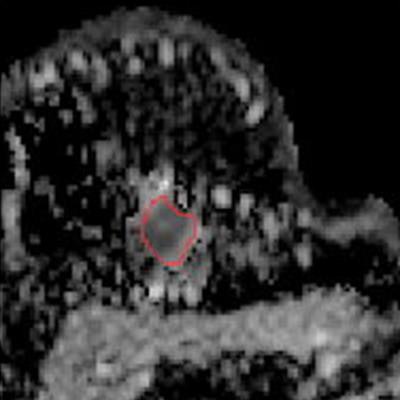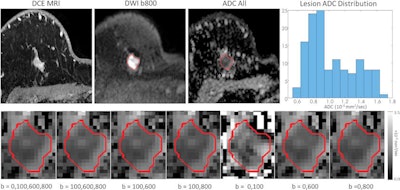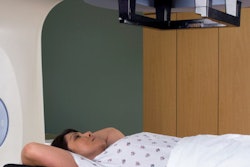
A new prospective trial published on November 17 in Radiology has identified multiple metrics on diffusion-weighted MRI (DWI-MRI) scans that can reduce the number of unnecessary breast biopsies while maintaining the excellent diagnostic performance of contrast-enhanced MRI.
One of the most promising combinations was the use of mean apparent diffusion coefficient (ADC) with only two b-values instead of the standard four b-values. This simpler protocol reduced unnecessary biopsies by up to 22% and paves the way for DWI-MRI use in abbreviated protocols.
"Our results ... suggest that mean ADC alone, potentially with use of only two b-values, is sufficient to improve specificity of conventional contrast-enhanced breast MRI and to reduce unnecessary biopsies," wrote the authors, led by Dr. Elizabeth McDonald, PhD, from the University of Pennsylvania Perelman School of Medicine.
Contrast-enhanced breast MRI has excellent sensitivity but can result in a higher number of unnecessary biopsies. DWI-MRI is one technique that has shown promise to cut the unnecessary biopsy rate on breast MRI, but clinical standards have not yet been established for its use in breast imaging.
When performing breast DWI-MRI, clinicians most often use the mean ADC value across lesions, although alternative ADC metrics have been proposed. McDonald's research team evaluated multiple ADC metrics and b-values in order to find the combination with the best overall sensitivity and specificity.
The study population included 67 women with 81 BI-RADS 3, 4, or 5 lesions identified on 1.5-tesla or 3-tesla contrast-enhanced MRI. The team used the images to calculate ADC with seven whole-lesion metrics and as well as various combinations of four available b-values (0 sec/mm2, 100 sec/mm2, 600 sec/mm2, and 800 sec/mm2).
 Malignant breast lesion in a 41-year-old woman who underwent axial dynamic contrast material-enhanced (DCE) MRI. Top row, left to right: (1) T1-weighted postcontrast image, (2) DWI image with 800 sec/mm2 b-value, (3) ADC map with all four b-values, (4) ADC histogram for lesion region of interest. Bottom row: ADC maps generated for various b value combinations. Image courtesy of RSNA.
Malignant breast lesion in a 41-year-old woman who underwent axial dynamic contrast material-enhanced (DCE) MRI. Top row, left to right: (1) T1-weighted postcontrast image, (2) DWI image with 800 sec/mm2 b-value, (3) ADC map with all four b-values, (4) ADC histogram for lesion region of interest. Bottom row: ADC maps generated for various b value combinations. Image courtesy of RSNA.The current standard of mean ADC with all four b-values proved its worth in the study, demonstrating an area under the curve (AUC) of 0.75. This combination would have avoided biopsies of 14 lesions in the study population, yielding a 21% reduction in the biopsy rate.
However, mean ADC performed just as well with the use of fewer b-values. The team found no significant differences in AUC when using they used just two or three b-values instead of all four.
In fact, using only 100 sec/mm2 and 800 sec/mm2 would have reduced the biopsy rate by 22%. Similarly, the more widely proposed recommendation of using just 0 sec/mm2 and 800 sec/mm2 would have reduced the rate by 19%.
"Our findings build on previous studies investigating optimal b-value combinations and support using the two b-value combination of 0 and 800 sec/mm2 as proposed in recent consensus recommendations," the authors wrote.
The results are promising because the use of fewer b-values could mean clinicians can cut down on DWI-MRI scan time, improving its suitability for abbreviated protocols. However, the authors cautioned a larger sample size is needed to identify more subtle differences in diagnostic performance and standardize the approach for clinical use.
"An important next step toward clinical standardization is to validate the performance of diffusion-weighted MRI using the data and optimal cutoffs learned from this trial in larger retrospective data sets and/or prospective trials," they concluded.




















